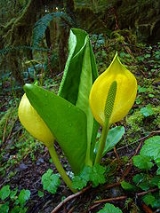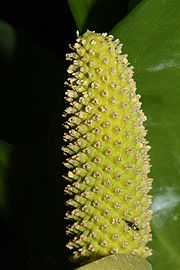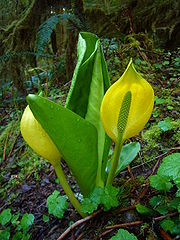
Western Skunk Cabbage
Encyclopedia
Western Skunk Cabbage also called Yellow Skunk Cabbage or Swamp Lantern, is a plant found in swamps and wet woods, along streams and in other wet areas of the Pacific Northwest
, where it is one of the few native species in the arum family
. The plant is called Skunk Cabbage because of the distinctive "skunky" odor that it emits. This odor will permeate the area where the plant grows, and can be detected even in old, dried specimens. The distinctive odor attracts its pollinators, scavenging flies
and beetle
s. Although similarly named and with a similar smell, the plant is easy to distinguish from the Eastern Skunk Cabbage (Symplocarpus foetidus), another species in the arum family found in eastern North America.
 The plant grows from rhizome
The plant grows from rhizome
s that measure 30 cm or longer, and 2.5 to 5 cm in diameter. The leaves
are the largest of any native plant in the region, 50–135 cm long and 30–80 cm wide when mature. Its flower
s are produced in a spadix
contained within a large, bright yellow or yellowish green spathe 30–40 cm tall; it is among the first flowers to appear in spring. The blooming stem produces heat, which can be sufficient to melt the snow around the plant.
and Cook Inlet
, Alaska
south through British Columbia
, Washington, Oregon
, and Northern California
as far south as Santa Cruz County
. Isolated populations are also found in northeastern Washington, northern Idaho
, Montana
, and Wyoming
.
The plant was introduced into cultivation in the United Kingdom
in 1901 and has escaped to become naturalized in marshy areas in Britain
and Ireland
, for example in Hampshire
and Surrey
, including Wisley Gardens, and in the north and west of the UK.
, its roots are food for bear
s, who eat it after hibernating as a laxative
or cathartic
. The plant was used by indigenous people as medicine for burns and injuries, and for food in times of famine, when almost all parts were eaten. The leaves have a somewhat spicy or peppery taste. Caution should be used in attempts to prepare Western Skunk Cabbage for consumption, as it contains calcium oxalate
crystals, which result in a gruesome prickling sensation on the tongue and throat and can result in intestinal irritation and even death if consumed in large quantities. Although the plant was not typically part of the diet under normal conditions, its large, waxy leaves were important to food preparation and storage. They were commonly used to line berry baskets and to wrap around whole salmon and other foods when baked under a fire. It is also used to cure sores and swelling.
It has been used as an ornamental garden plant in Britain
and Ireland
, where it grows well in marshy conditions. Hybrids with Lysichiton camtschatcense, called Lysichiton ×hortensis, are also cultivated. These have larger spathes than either of the parents.

Pacific Northwest
The Pacific Northwest is a region in northwestern North America, bounded by the Pacific Ocean to the west and, loosely, by the Rocky Mountains on the east. Definitions of the region vary and there is no commonly agreed upon boundary, even among Pacific Northwesterners. A common concept of the...
, where it is one of the few native species in the arum family
Araceae
Araceae are a family of monocotyledonous flowering plants in which flowers are borne on a type of inflorescence called a spadix. The spadix is usually accompanied by, and sometimes partially enclosed in, a spathe or leaf-like bract. Also known as the Arum family, members are often colloquially...
. The plant is called Skunk Cabbage because of the distinctive "skunky" odor that it emits. This odor will permeate the area where the plant grows, and can be detected even in old, dried specimens. The distinctive odor attracts its pollinators, scavenging flies
Fly
True flies are insects of the order Diptera . They possess a pair of wings on the mesothorax and a pair of halteres, derived from the hind wings, on the metathorax...
and beetle
Beetle
Coleoptera is an order of insects commonly called beetles. The word "coleoptera" is from the Greek , koleos, "sheath"; and , pteron, "wing", thus "sheathed wing". Coleoptera contains more species than any other order, constituting almost 25% of all known life-forms...
s. Although similarly named and with a similar smell, the plant is easy to distinguish from the Eastern Skunk Cabbage (Symplocarpus foetidus), another species in the arum family found in eastern North America.
Description

Rhizome
In botany and dendrology, a rhizome is a characteristically horizontal stem of a plant that is usually found underground, often sending out roots and shoots from its nodes...
s that measure 30 cm or longer, and 2.5 to 5 cm in diameter. The leaves
Leaf
A leaf is an organ of a vascular plant, as defined in botanical terms, and in particular in plant morphology. Foliage is a mass noun that refers to leaves as a feature of plants....
are the largest of any native plant in the region, 50–135 cm long and 30–80 cm wide when mature. Its flower
Flower
A flower, sometimes known as a bloom or blossom, is the reproductive structure found in flowering plants . The biological function of a flower is to effect reproduction, usually by providing a mechanism for the union of sperm with eggs...
s are produced in a spadix
Spadix
In botany, a spadix is a type of spike inflorescence having small flowers borne on a fleshy stem. Spadix are typical of the Family Araceae known as arums or aroids...
contained within a large, bright yellow or yellowish green spathe 30–40 cm tall; it is among the first flowers to appear in spring. The blooming stem produces heat, which can be sufficient to melt the snow around the plant.
Range
L. americanus is found from Kodiak IslandKodiak Island
Kodiak Island is a large island on the south coast of the U.S. state of Alaska, separated from the Alaska mainland by the Shelikof Strait. The largest island in the Kodiak Archipelago, Kodiak Island is the second largest island in the United States and the 80th largest island in the world, with an...
and Cook Inlet
Cook Inlet
Cook Inlet stretches from the Gulf of Alaska to Anchorage in south-central Alaska. Cook Inlet branches into the Knik Arm and Turnagain Arm at its northern end, almost surrounding Anchorage....
, Alaska
Alaska
Alaska is the largest state in the United States by area. It is situated in the northwest extremity of the North American continent, with Canada to the east, the Arctic Ocean to the north, and the Pacific Ocean to the west and south, with Russia further west across the Bering Strait...
south through British Columbia
British Columbia
British Columbia is the westernmost of Canada's provinces and is known for its natural beauty, as reflected in its Latin motto, Splendor sine occasu . Its name was chosen by Queen Victoria in 1858...
, Washington, Oregon
Oregon
Oregon is a state in the Pacific Northwest region of the United States. It is located on the Pacific coast, with Washington to the north, California to the south, Nevada on the southeast and Idaho to the east. The Columbia and Snake rivers delineate much of Oregon's northern and eastern...
, and Northern California
Northern California
Northern California is the northern portion of the U.S. state of California. The San Francisco Bay Area , and Sacramento as well as its metropolitan area are the main population centers...
as far south as Santa Cruz County
Santa Cruz County, California
Santa Cruz County is a county located on the Pacific coast of the U.S. state of California, on the California Central Coast. The county forms the northern coast of the Monterey Bay. . As of the 2010 U.S. Census, its population was 262,382. The county seat is Santa Cruz...
. Isolated populations are also found in northeastern Washington, northern Idaho
Idaho
Idaho is a state in the Rocky Mountain area of the United States. The state's largest city and capital is Boise. Residents are called "Idahoans". Idaho was admitted to the Union on July 3, 1890, as the 43rd state....
, Montana
Montana
Montana is a state in the Western United States. The western third of Montana contains numerous mountain ranges. Smaller, "island ranges" are found in the central third of the state, for a total of 77 named ranges of the Rocky Mountains. This geographical fact is reflected in the state's name,...
, and Wyoming
Wyoming
Wyoming is a state in the mountain region of the Western United States. The western two thirds of the state is covered mostly with the mountain ranges and rangelands in the foothills of the Eastern Rocky Mountains, while the eastern third of the state is high elevation prairie known as the High...
.
The plant was introduced into cultivation in the United Kingdom
United Kingdom
The United Kingdom of Great Britain and Northern IrelandIn the United Kingdom and Dependencies, other languages have been officially recognised as legitimate autochthonous languages under the European Charter for Regional or Minority Languages...
in 1901 and has escaped to become naturalized in marshy areas in Britain
Great Britain
Great Britain or Britain is an island situated to the northwest of Continental Europe. It is the ninth largest island in the world, and the largest European island, as well as the largest of the British Isles...
and Ireland
Ireland
Ireland is an island to the northwest of continental Europe. It is the third-largest island in Europe and the twentieth-largest island on Earth...
, for example in Hampshire
Hampshire
Hampshire is a county on the southern coast of England in the United Kingdom. The county town of Hampshire is Winchester, a historic cathedral city that was once the capital of England. Hampshire is notable for housing the original birthplaces of the Royal Navy, British Army, and Royal Air Force...
and Surrey
Surrey
Surrey is a county in the South East of England and is one of the Home Counties. The county borders Greater London, Kent, East Sussex, West Sussex, Hampshire and Berkshire. The historic county town is Guildford. Surrey County Council sits at Kingston upon Thames, although this has been part of...
, including Wisley Gardens, and in the north and west of the UK.
Uses
While some consider the plant to be a weedWeed
A weed in a general sense is a plant that is considered by the user of the term to be a nuisance, and normally applied to unwanted plants in human-controlled settings, especially farm fields and gardens, but also lawns, parks, woods, and other areas. More specifically, the term is often used to...
, its roots are food for bear
Bear
Bears are mammals of the family Ursidae. Bears are classified as caniforms, or doglike carnivorans, with the pinnipeds being their closest living relatives. Although there are only eight living species of bear, they are widespread, appearing in a wide variety of habitats throughout the Northern...
s, who eat it after hibernating as a laxative
Laxative
Laxatives are foods, compounds, or drugs taken to induce bowel movements or to loosen the stool, most often taken to treat constipation. Certain stimulant, lubricant, and saline laxatives are used to evacuate the colon for rectal and/or bowel examinations, and may be supplemented by enemas under...
or cathartic
Cathartic
In medicine, a cathartic is a substance that accelerates defecation. This is in contrast to a laxative, which is a substance which eases defecation, usually by softening feces. It is possible for a substance to be both a laxative and a cathartic...
. The plant was used by indigenous people as medicine for burns and injuries, and for food in times of famine, when almost all parts were eaten. The leaves have a somewhat spicy or peppery taste. Caution should be used in attempts to prepare Western Skunk Cabbage for consumption, as it contains calcium oxalate
Calcium oxalate
Calcium oxalate is a chemical compound that forms needle-shaped crystals, known in plants as raphides. A major constituent of human kidney stones, the chemical is also found in beerstone, a scale that forms on containers used in breweries...
crystals, which result in a gruesome prickling sensation on the tongue and throat and can result in intestinal irritation and even death if consumed in large quantities. Although the plant was not typically part of the diet under normal conditions, its large, waxy leaves were important to food preparation and storage. They were commonly used to line berry baskets and to wrap around whole salmon and other foods when baked under a fire. It is also used to cure sores and swelling.
It has been used as an ornamental garden plant in Britain
Britain
Britain may refer to:* United Kingdom of Great Britain and Northern Ireland, a state in western Europe* Great Britain, the largest island in the British Isles* Britain, Virginia, an unincorporated village in Loudoun County, Virginia, USA...
and Ireland
Ireland
Ireland is an island to the northwest of continental Europe. It is the third-largest island in Europe and the twentieth-largest island on Earth...
, where it grows well in marshy conditions. Hybrids with Lysichiton camtschatcense, called Lysichiton ×hortensis, are also cultivated. These have larger spathes than either of the parents.
See also

- Asian Skunk CabbageLysichiton camtschatcensisLysichiton camtschatcensis, common name Asian Skunk Cabbage or White Skunk Cabbage, is a plant found in swamps and wet woods, along streams and in other wet areas of the Kamchatka Peninsula, the Kuril Islands, Sakhalin and Japan...
: From north-east Asia - Eastern Skunk CabbageEastern Skunk CabbageEastern Skunk Cabbage, Clumpfoot Cabbage, Foetid Pothos, Meadow Cabbage, Polecat Weed, Skunk Cabbage, or Swamp Cabbage , commonly known as simply Skunk Cabbage, is a low growing, foul smelling plant that prefers wetlands...
: Although not in the same genus (Symplocarpus foetidus), it is often confused with Western Skunk Cabbage - Bog Arum: A similar plant grown as an ornamental herbaceous perennial.

